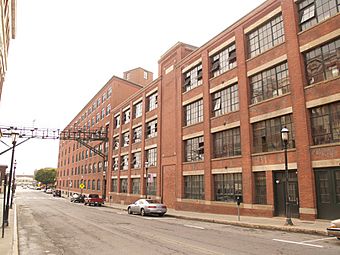Heywood-Wakefield Company Complex facts for kids
|
Heywood-Wakefield Company Complex
|
|
|
U.S. Historic district
Contributing property |
|
 |
|
| Location | 206 Central St., Gardner, Massachusetts |
|---|---|
| Area | 12.5 acres (5.1 ha) |
| Built | 1863 |
| Part of | West Gardner Square Historic District (ID85003185) |
| NRHP reference No. | 83000610 |
Quick facts for kids Significant dates |
|
| Added to NRHP | September 15, 1983 |
| Designated CP | December 30, 1985 |
The Heywood-Wakefield Company Complex is a historic factory in Gardner, Massachusetts. You can find it at 206 Central Street. This group of buildings is in the West Gardner area. It started as a chair-making business in 1826. The Heywood brothers were the ones who began it. The brick factory buildings you see today were built later in the 1800s. This important place was added to the National Register of Historic Places in 1983.
Contents
The Heywood-Wakefield Factory Story
Gardner has a long history of making chairs. It all began in 1805 when James Comee started making them by hand. Walter Heywood learned from him as an apprentice. Walter and his brother William opened their own shops in the 1820s. Their first shop, near the old town center, burned down in 1834.
Building a New Beginning
Levi Heywood, another brother, built a new shop in 1835. This new shop was on the same spot as the factory buildings we see today. This move was a big deal for the town. The Heywood family's success helped shift Gardner's main business area. It moved to West Gardner, where it still is today.
Growing the Factory Complex
The factory complex covers about 12.5 acres. It stretches from Lake Street to Cross Street in downtown Gardner. Central Street cuts through the northern part of the complex. None of the original buildings from 1835 are left. A fire in 1860 destroyed most of them.
The oldest building still standing is from 1863. It was part of the rebuilding after the fire. Over time, the factory grew with more buildings and expansions. In 1897, the Heywood company joined with the Wakefield Rattan Company. This merger led to even more growth.
Challenges and Changes
The company faced tough times in the 1900s. They had strong competition and problems with workers. The factory finally closed its doors in 1978. Since then, the old factory buildings have found new uses. They are now home to different businesses and activities.



